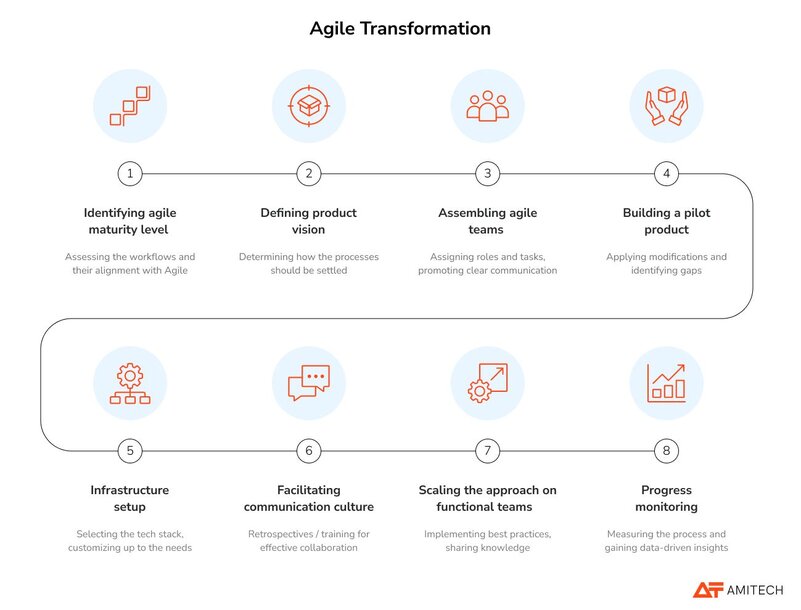Blog post
Methodology
🕒 10 min
Seven Steps to an Agile Organization
Being agile is crucial. We share our take on how to drive an agile transformation and call it a success

The term agile transformation goes beyond industry jargon, leading to substantial progress in the corporate landscape. Multiple success stories attest to the tangible impact companies achieve with the paradigm shift. However, navigating this transformative journey is not without its challenges. Obstacles such as cultural resistance, protracted timelines, and the need for unwavering leadership commitment can impede agility.
This article explores agile methodology, including real-life examples and a step-by-step guide for achieving success.
What agile transformation means in eCommerce
Agile methodologies have reshaped the landscape of eCommerce projects, software, and app development over the last two decades. This approach champions a continuous improvement cycle, swiftly exposing flaws and faults in the development process.
The Agile approach offers multiple advantages, including shorter development cycles, broader market reach, early customer feedback, and continuous improvement. The goal is to achieve rapid, reliable, and positive business results that may not be possible when adhering to rigid processes.
For eCommerce businesses, Agile transformation holds significant benefits that resonate with the dynamics of the modern business world.
Increased speed and flexibility
The two key attributes that set Agile apart from conventional approaches like the Waterfall methodology. Agile's process flows simplify production from start to finish, ensuring adaptability in a changing environment.
Understanding market interest
Continuous improvement helps businesses identify unnecessary features, aligning their offerings with customer needs and market trends. This adaptability is crucial in an era where customer requirements dynamically vary.
Better product quality
Quality assurance and maintenance become a continuous loop, improving products and aligning with evolving customer needs. Bugs, performance issues, or security flaws are detected and addressed in early iterations, leading to efficient, revenue-generating eCommerce products.
Risk management
The incremental Agile approach allows for addressing obstacles and maintaining transparency throughout development. Rapid release and delivery of eCommerce projects, coupled with quick customer feedback analysis, contribute to a reduced risk of failure.
Increased customer loyalty
Businesses focus on high-quality products, rapid improvements, and faster delivery. Agile shifts the focus from building features to delivering business value that enhances customer satisfaction.
A seven-step process for success
Done right, the agile transformation can bring tangible improvements. This guide was field-tested across multiple teams and projects in various niches. The essential steps outline how the Amitech Group experts address the transformation process, from assessment to a scaled agile framework across teams while emphasizing communication, culture, and continuous self-improvement.
1. Assessing workflows
Defining how the process should be settled and identifying stakeholders to communicate the ideas
Establishing the team composition, setting up communication channels, and outlining decision-making processes
2. Assembling agile teams
Ensuring effective and transparent communication to relay this organizational setup to the respective teams
Promoting clarity and alignment across the board
3. Pilot implementation
As part of this process, conducting a comprehensive evaluation to analyze the introduced changes, while identifying gaps used in previous frameworks
The Agile transformation workflow
4. Framework and tool configuration
Customization of tools, such as Jira, to cater to the team's specific requirements
5. Cultivating communication and self-improvement culture
Conducting retrospectives to provide a dedicated platform for the entire team to identify areas for improvement. This enables teams to take ownership of their growth and development, which enhances their overall performance.
6. Scaling solutions
Creating an effective knowledge-sharing network within the entire organizational ecosystem
Sharing the lessons learned and achievements to drive excellence throughout the organization
7. Monitoring progress
Leveraging tools like Jira, you can collect a wealth of technical and product-related metrics
Reaping valuable insights for informed decision-making and ensuring that everyone is aligned with the organization's goals
Feel free to ask for professional advice to guide you through the agile transformation process 🛠️
Putting into practice: a real-world case study
The customer is a US-based retailer selling organic products and cookware. The company turned to Amitech Group to optimize a website by migrating to a modern tech stack.
Our journey into agile transformation began with the optimization and maintenance of three critical website components. However, we quickly encountered challenges, since the customer lacked a clear understanding of leveraging the delivered solution. Additionally, the customer outsourced some technical tasks to third-party service providers who usually submitted their requests in a chaotic manner. The collaboration added another layer of complexity to our work.
The core challenges breakdown:
Communication overload. Multiple communication channels created confusion and made backlog organization and prioritization challenging.
To address these challenges, we took the following steps:
Dedicated teams. We established new teams and clarified roles within the organization. By introducing a Product Owner, Agile coach, and client representative, we could determine main features and priorities.
Data-driven prioritization. Our team implemented prioritization techniques (e.g., the Weighted Shortest Job First approach) to streamline backlog management and decision-making.
Ongoing training. Recognizing the need for continuous improvement, Amitech Group experts conducted multiple sessions to impart the principles of Agile.
Custom workflow. The testing was conducted on the customer side. So we introduced a customized workflow to include the external workflow in the development life cycle.
As a result, the customer managed to:
Focus on metrics and user data to boost customer retention and loyalty
Restructure teams for cost optimization and value delivery
Accelerate team capabilities by adopting the culture of learning and improvement
Making agility work for your organization
In recent years, agility has shifted from theory to practice, becoming mainstream across various sectors. Depending on where you are at in this journey, here are some insights to drive the new operating model:
If you are at your starting point
The transformation journey requires thorough preparation. Ensure leadership grasps the shift and is ready to role-model the new mindset.
If you are in progress
Take pauses to look around and evaluate your approach. Ensure the transformation is about value creation and a priority for leadership. Adhere to the strategy so that it brings the impact you are striving for.
If you are not seeing any change
Try to reflect on what was done and what was not. Identify the flaws in the plan. It is possible that you had high expectations at the beginning. Alternatively, you may have relied on external experts to drive change instead of focusing on internal efforts.
If you succeeded and are looking for ways to build on that
No transformation is a go-to recipe across all cases. Adapt your approach, test hypotheses, and evolve your operating model to meet new market demands.
Last updated: October 27, 2023
About the authors

Orchestrating agile transformations within diverse organizations, seamlessly guiding extensive teams of 150+ developers toward innovation and efficiency.

Adept at crafting engaging and user-friendly copy about software technology, cloud computing, and eCommerce development.
Keep track on latest trends in web
Let’s nail another market-shaking project together! While you are thinking, check out our latest ones.


